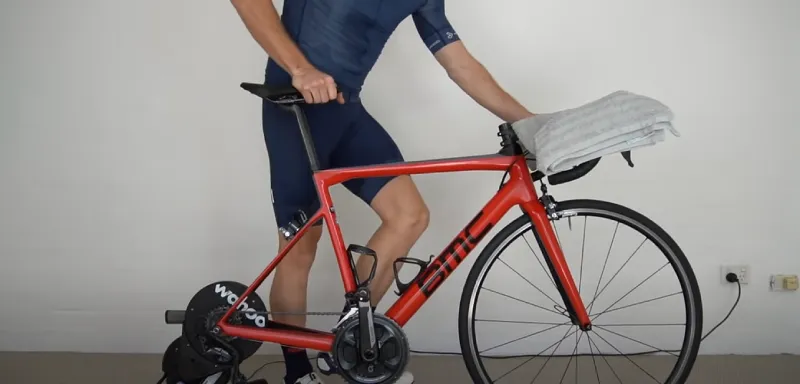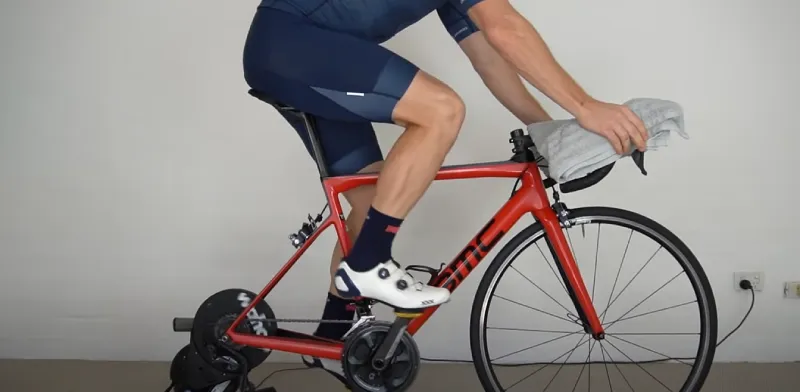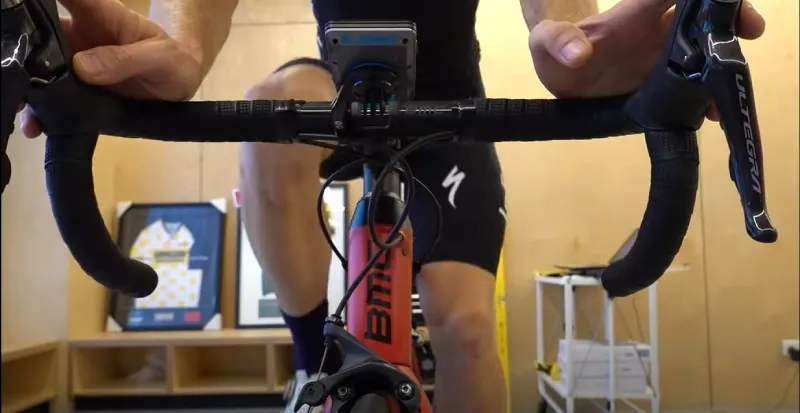Nerve leg pain is called radiculopathy or sciatica. It originates from issues in the lumbar and sacral spine nerve roots. This pain occurs when these nerve roots become inflamed, irritated, or compressed.
Hemorrhoids do not directly cause nerve pain in the legs, but they may put pressure on pelvic nerves, leading to referred pain in the legs.
Cycling can worsen hemorrhoids but doesn’t typically result in leg nerve pain. To prevent additional discomfort, it’s recommended to pause cycling until the hemorrhoids improve.
This blog post will explain how hemorrhoids cause nerve pain in the legs when cycling, how to mitigate risks, and how to ride comfortably.
Hemorrhoids Cause Nerve Pain In Legs For Cycling: 6 Signs

Hemorrhoids, which are swollen veins in the lower rectum and anus, are a common condition that can cause discomfort and pain. While they primarily affect the anal area, there can be indirect implications for cyclists, potentially affecting comfort and performance because of cycling posture and seat pressure. Here’s how hemorrhoids might relate to leg and nerve pain, particularly in cycling:
Cycling Cause Hemorrhoids
Cycling itself does not directly cause hemorrhoids, but the prolonged sitting on a bicycle saddle without proper support or frequent breaks can exacerbate existing hemorrhoids. The pressure from the bike seat can restrict blood flow in the pelvic area, potentially worsening the symptoms of pre-existing hemorrhoids.
Hemorrhoids Cause Leg Pain
While hemorrhoids do not directly cause leg pain, the discomfort and pain from significant or thrombosed hemorrhoids can make sitting or certain movements uncomfortable, potentially altering your gait or posture in a way that might indirectly cause leg discomfort or pain.
Hemorrhoids Cause Nerve Pain
Direct nerve pain from hemorrhoids is unusual since hemorrhoids themselves rarely press on nerves that would cause radiating pain. However, severe and chronic conditions might lead to an overall increase in discomfort that feels akin to nerve pain, especially in the pelvic region.
Hemorrhoids Cause Sciatic Pain
There is no direct connection between hemorrhoids and sciatica. Sciatica is caused by irritation or compression of the sciatic nerve, often because of issues like herniated discs or spinal stenosis. Hemorrhoids do not affect the sciatic nerve, but the discomfort and change in posture because of hemorrhoids might exacerbate underlying back issues, indirectly affecting sciatica symptoms.
Hemorrhoids Cause Back Leg Pain
Again, hemorrhoids do not directly cause back leg pain. Any such pain is likely coincidental or related to changes in posture or walking style because of the discomfort caused by hemorrhoids, rather than the hemorrhoids pressing on nerves that supply the legs.
Hemorrhoids Affect Your Legs
Indirectly, severe hemorrhoids might influence leg comfort or function through changes in posture, sitting habits, or walking style, as mentioned. Prolonged discomfort from hemorrhoids might lead to a reluctance to maintain certain positions or partake in activities, potentially reducing leg muscle use and causing stiffness or discomfort.
Hemorrhoids Can Cause Nerve Pain In The Legs While Cycling 5 Clarification
The rectum and anus of your lower body may be swollen with hemorrhoids. Can these swellings cause nerve pain in your legs while cycling? Could hemorrhoids be the source of leg pain, especially after cycling? Let’s explore this and address common questions.
Unraveling the Connection
Hemorrhoids are a common issue, but their potential to cause leg nerve pain, especially among cyclists, is a topic worth exploring. Here, we’ll look at how these two could be connected.
- Anatomy 101: Hemorrhoids don’t directly touch leg nerves. The discomfort and swelling can lead to changes in how you sit or cycle, potentially affecting nerves indirectly.
- Pressure Points: Prolonged cycling, especially on hard seats, increases pressure in the pelvic region, which can exacerbate hemorrhoid discomfort and indirectly affect leg nerves.
- Inflammation: Hemorrhoids can cause inflammation that, in rare cases, might spread or influence areas beyond the immediate vicinity, possibly impacting nerves.
Body Mechanics Explored
To fully grasp how hemorrhoids could lead to leg nerve pain, a quick anatomy and physiology lesson is in order. Let’s break down the body mechanics involved.
- The Pelvic Region: This area is a complex network of bones, muscles, veins, and nerves. Hemorrhoids increase pressure here, which can have a domino effect.
- Nerve Pathways: The sciatic nerve, running from the lower back to the feet, passes through this high-pressure zone. Changes in pelvic pressure can affect this nerve.
- Cycling Posture: How you sit on a bicycle can strain certain body parts, including the pelvic area, potentially aggravating symptoms.
Direct vs. Indirect Pain
There’s a lot of information out there, but not all of it is accurate. Let’s clear up what’s true and what’s myth regarding hemorrhoids and leg nerve pain in cyclists.
- Direct Connection Myth: There is no direct pathway from hemorrhoids to leg nerve pain. The two are related more indirectly than many think.
- Indirect Issues: Changes in posture, pressure, and potential hemorrhoid inflammation can lead to discomfort or leg pain.
- Understanding Symptoms: Recognizing direct pain (caused by something affecting the nerve) and indirect pain can help find the right solutions.
Through the Cyclist’s Lens
Nothing speaks louder than personal experiences. Here, cyclists share their stories of dealing with hemorrhoids and the resulting leg nerve pain.
- Personal Accounts: Many cyclists have noticed increased discomfort and pain in their legs when dealing with hemorrhoids, especially on long rides.
- Adjustments and Solutions: From changing seat types and positions to incorporating more breaks, cyclists have found ways to manage and reduce discomfort.
- Medical Consultations: In some cases, seeking professional medical advice was necessary to address the underlying issues and find relief.
The Strain of the Sport
The challenge of cycling is part of its appeal. It pushes the body’s limits, particularly in the lower half. Unfortunately, this physical demand can aggravate symptoms associated with piles such as pain and itching, making the ride less pleasant.
- Physical Demand: Cycling exerts considerable strain on the body, focusing on the pelvic area.
- Symptom Trigger: This intense effort can trigger or worsen symptoms related to hemorrhoids.
Risk Management for Cycling With Hemorrhoids

You can stay fit by cycling, but it’s essential to manage risks. Lower rectum piles, or swollen veins in the rectus and anus, can cause discomfort. Let’s explore how to prevent and treat them.
Cycling Tips to Prevent Hemorrhoids
Hemorrhoids are swellings of the lower rectum or anus. While they’re commonly associated with prolonged sitting, they can also affect cyclists due to pressure and friction from cycling seats. Simple yet effective ways to avoid them:
- Adjust your riding style: Regularly change your position on the seat to reduce pressure on sensitive areas.
- Take frequent breaks: During long rides, stop and stretch to improve blood flow and decrease pressure on the pelvic area.
- Stay active off the bike: Incorporate exercises that strengthen the pelvic floor and rectal muscles.
Gear Up Right
Simple steps can go a long way in preventing hemorrhoids:
- Choose a well-padded seat: A seat with ample padding can distribute weight more evenly, reducing pressure.
- Consider a split-seat design: These seats decrease pressure on the perineal area, lowering the risk of developing hemorrhoids.
- Wear proper cycling shorts: Quality shorts provide additional padding and reduce pedaling friction.
Fuel and Hydration
You need to eat and drink right to prevent hemorrhoids:
- Stay hydrated: Staying hydrated keeps stools soft, making them easier to pass.
- Eat a fiber-rich diet: Foods high in fiber, like fruits, vegetables, and whole grains, help prevent constipation and straining.
Healing on Wheels
Even with preventive measures, some cyclists may still experience piles. Here’s how to address them:
- Over-the-counter solutions: Creams, ointments, and suppositories can offer relief.
- Professional consultations: If symptoms persist, seeking advice from a healthcare provider is essential. They can recommend treatments like rubber band ligation or surgery for severe cases.
Beneficial Exercises and Stretches for Symptom Relief
Incorporating specific exercises and stretches can alleviate discomfort and aid in recovery:
- Kegel exercises: Strengthen the muscles around the anus.
- Gentle yoga: Poses like Child’s Pose and Wind Relieving Pose can reduce pressure on the abdominal and pelvic regions.
Tips and Tricks for Cycling Comfortably

Cycling is a great way to stay fit and enjoy nature, but piles can make it uncomfortable. This guide offers tips to improve your cycling experience despite this issue.
Adjusting the Saddle
Your bicycle saddle plays a crucial role in determining your riding comfort levels. A few adjustments here can significantly alleviate discomfort caused by hemorrhoids.
- Choose the Right Saddle: Not all saddles are created equal. Opt for a saddle that complements your body type and minimizes pressure in sensitive areas.
- Adjust the Height: Ensuring that your saddle is positioned at the correct height is essential. A saddle that’s too high or too low can lead to unnecessary strain.
- Consider a Cushioned Cover: A cushioned saddle cover can make a difference for added comfort. It provides an extra layer of padding, reducing the impact on your hemorrhoids.
Posture and Technique
The way you sit and cycle can have a significant effect on your hemorrhoidal discomfort. Adopting the correct posture and technique is critical to minimizing this issue.
- Sit Up Straight: Maintaining a straight back while cycling helps evenly distribute your weight, thus reducing undue pressure on your veins. Make sure you keep a healthy weight.
- Change Positions: It’s crucial to vary your sitting position periodically during long rides to prevent putting constant pressure on the same areas.
- Take Breaks: Incorporating regular breaks into your cycling routine allows your body to relieve built-up pressure and improves blood circulation.
Pro Insights
Integrating medical guidance with insights from cycling experts can greatly enhance your cycling experience, especially when dealing with hemorrhoids.
- Consult a Professional: Before drastically altering your cycling routine, talk to a healthcare provider about managing your condition while staying active.
- Follow Expert Tips: Advice from professional cyclists who understand the nuances of cycling with hemorrhoids can be invaluable. They can offer specific tips tailored to your needs.
- Stay Informed: Keeping abreast of the latest studies and findings related to hemorrhoids and cycling keeps you informed about cycling habits and health.
Conclusion
After journeying through the uncomfortable yet important discussions surrounding hemorrhoids and cycling, it’s clear that this is more than just a matter of discomfort. It’s about understanding the intricate balance between our passion for cycling and health.
We’ve explored the evidence, debunked myths, and gathered insights from those who’ve pedaled through the pain. The road ahead for cyclists dealing with hemorrhoids isn’t necessarily one of ceaseless suffering. Instead, it’s paved with knowledge, preventive measures, and adjustments that can lead to a smoother ride.
From selecting the right gear to adopting better cycling habits and incorporating effective treatments, managing hemorrhoids while pursuing the love of cycling is entirely possible. So, to all the cyclists out there navigating this challenge, keep your spirits high and your seats comfortable.
Remember, the journey of understanding and addressing health concerns like hemorrhoids is a testament to your resilience. Ride ahead, not just with speed and endurance, but with the motivation to balance your passion with proactive health measures.
FAQs
Does The Leg Conundrum Have A Connection to Leg Pain?
The evidence does not definitively establish a direct connection between leg nerve pain and hemorrhoids. Discomfort from hemorrhoids could influence nearby nerves due to cycling posture and seat pressure.
The direct causation of leg nerve pain remains speculative. Health professionals caution against directly linking hemorrhoids to leg nerve pain without further conclusive evidence.


